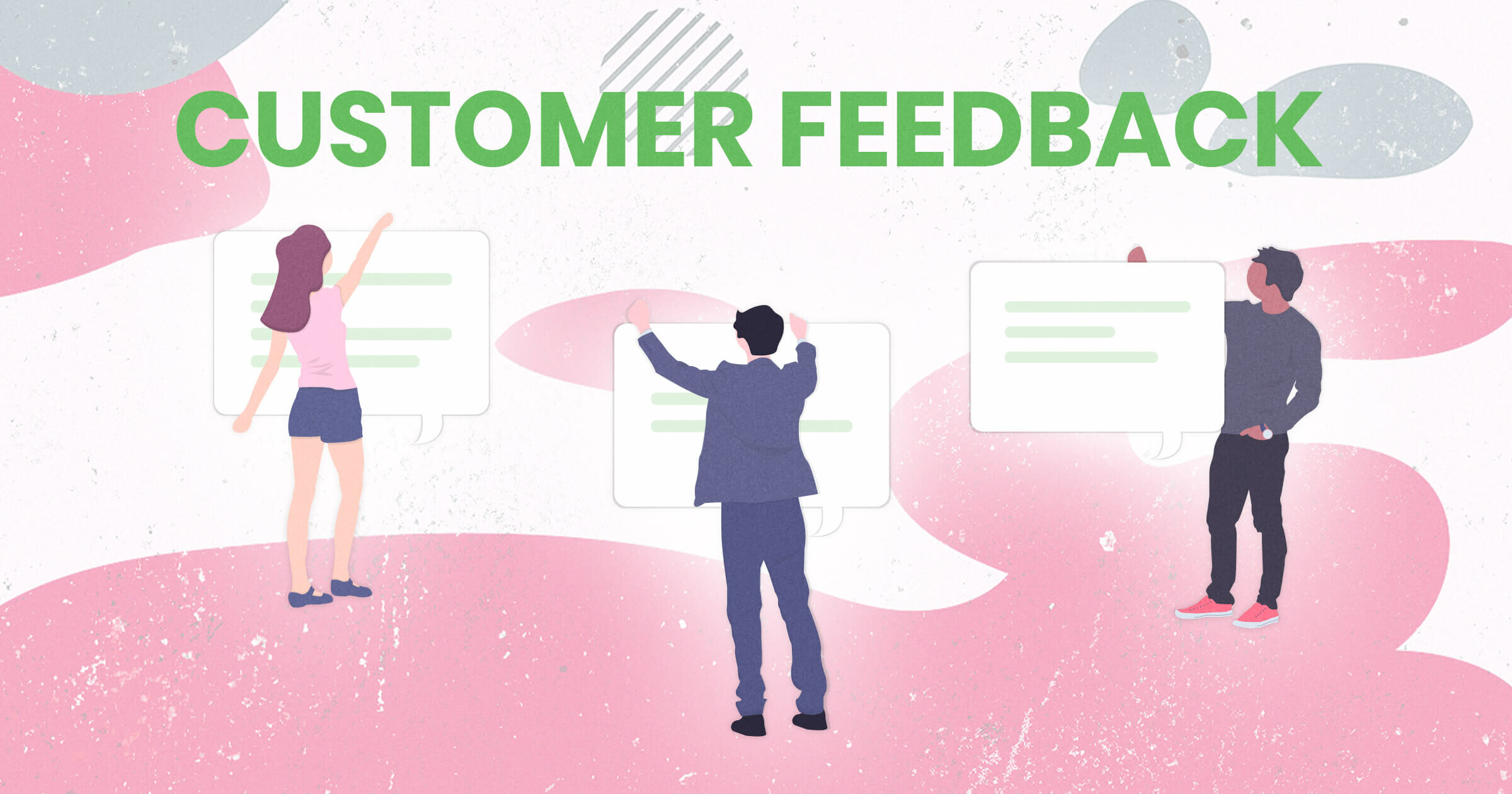Accepting customer feedback is essential to build a profitable business.
If you don’t know how your customers view your brand, you don’t know either when you’re falling short of expectations. And at the same time, you also don’t know why – or which – customers are happy, which can be just as important.
Knowing what your customers think can provide insight and serve as a guide forward. Customer feedback is how you increase customer satisfaction and loyalty.
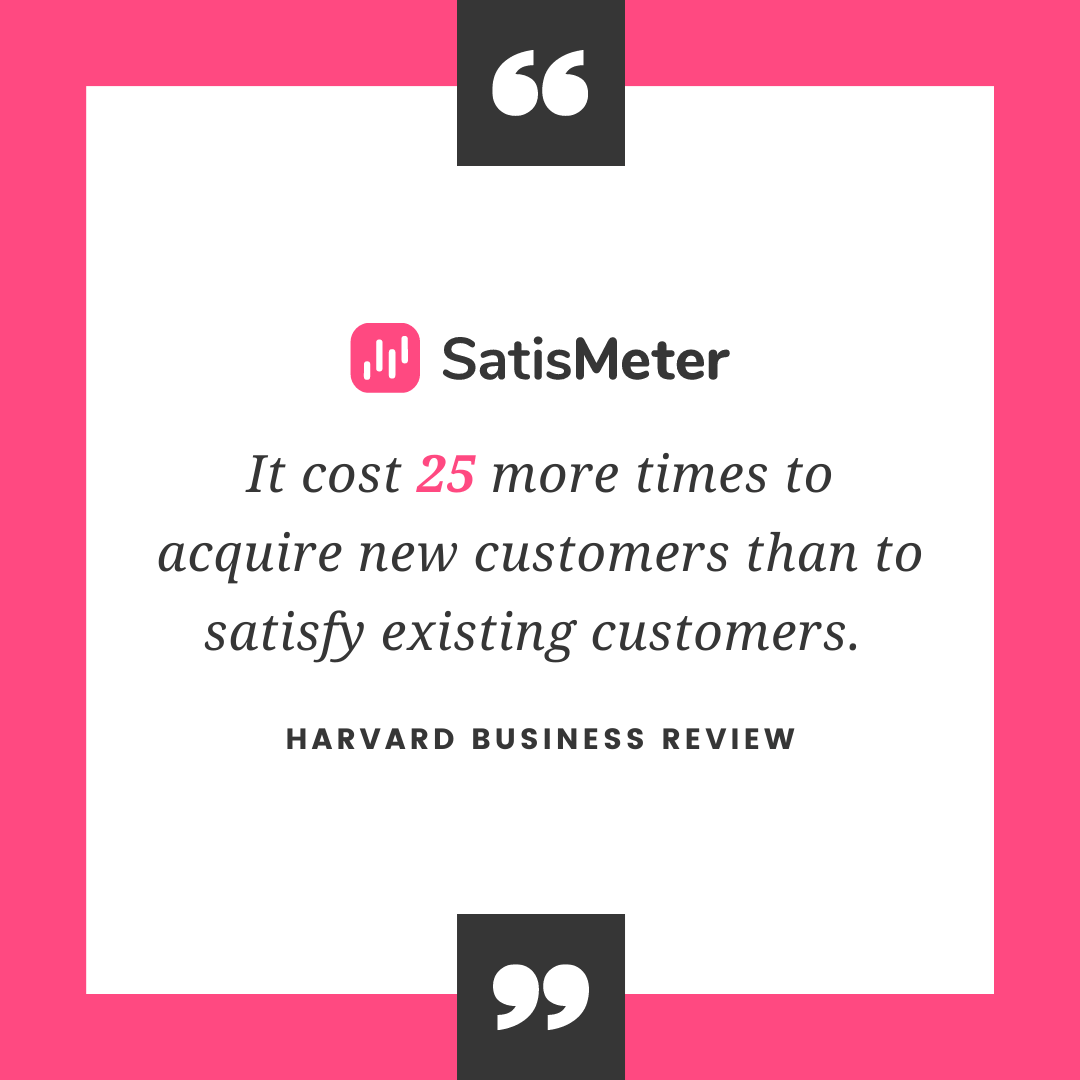
And loyal customers are your bread and butter. While seasonal rushes may provide a nice boost when you need them, it’s the returning customers time and time again that fill your coffers. Not to mention, loyal customers become more valuable over time. A Harvard Business Review article notes that:
- Increasing customer retention rates by 5% will increase profits by 25% to 95%
- It costs 5 to 25 times more to acquire new customers than to satisfy existing customers.
To this end, building repeat business is the way to succeed in the modern age. And asking for customer feedback is how you learn where you’re successful – or not – at keeping customers happy and turning them into loyal patrons.
Create your SatisMeter account now
The Importance of Customer Feedback
Customer feedback is important. Gathering it comes with many benefits, regardless of your industry, whether you’re part of the marketing team or the product team.
One of the most important, as we noted above, is that you can increase customer satisfaction. A satisfied customer is a loyal patron who spends more and complains less. And have we mentioned the effectiveness and low cost of word-of-mouth advertising?
Believe it or not, personal recommendations are one of the most significant factors in a customer’s buying decision. Of course, social media and Yelp reviews help. But a good word from friends and family affects every part of a customer’s decision to buy. By building loyal customers now, you generate future returns straight into your pocket.
When it comes to immediate benefits, accepting critiques can help you improve your website and online services. Gathering also negative feedback will definitely help your product improvement. Increasing ease of use, responsiveness, and enjoyability goes a long way toward making customers happy.
On the other hand, a poor design can lead to:
- Bounced customers
- Abandoned carts
- Lower conversions
- An insufficient return on investment
Additionally, both praise and criticism can help you tailor products to customers’ needs. You won’t sell products if your customers don’t want or don’t need what you have to offer. Though you don’t have to make every change, it’s still essential to understand your customers’ expectations.
Furthermore, customer feedback is one of the best ways to gauge how your customers found you. Knowing where your customers come from can help your tailor marketing efforts toward your most successful channels. At the same time, you can cut avenues that don’t turn a profit.
But most importantly, gathering customer feedback makes your patrons feel involved. Asking for – and acting upon – customer opinion is a crucial, underrated step in making them feel important and heard. It’s a critical step in establishing your customer success strategy.
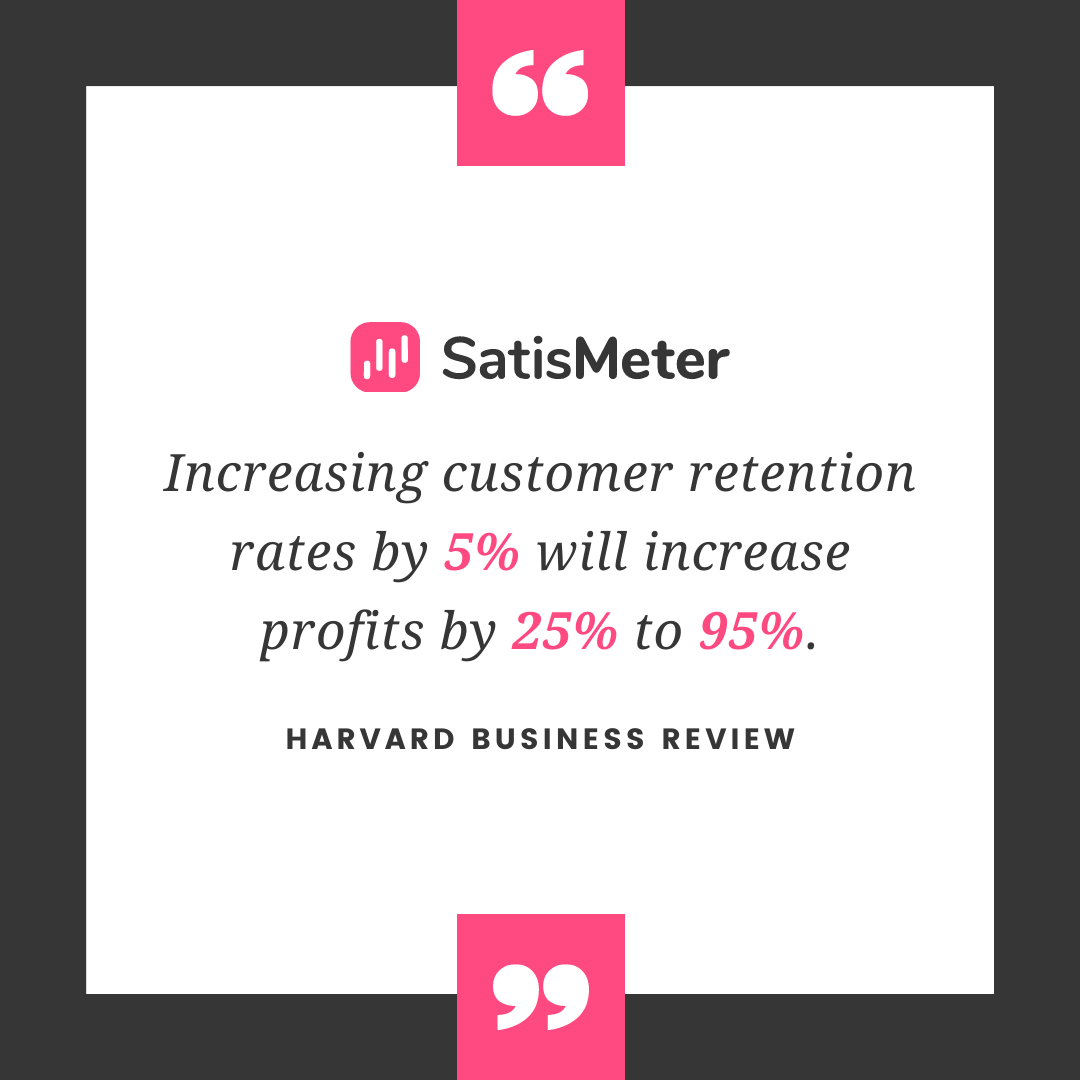
How to Gather Customer Feedback
There are several ways to gather customer feedback, mainly through the creation of a customer survey.
For instance, you may seek feedback via onsite, pop-up, apps surveys, or event-triggered surveys. But live chat conversations also serve as a valuable source of data.
Email surveys provide another way to collect feedback that allows your customers to answer questions on their own time. Gathering inspiration and information from social media is another valid method of collecting all sorts of juicy tidbits.
Of course, these fundamental strategies are all well and even more powerful if you’re using the right customer feedback tool to compile and analyze the data for you!)
But if you want to be effective at not only gathering but implementing, your data, it’s time to become familiar with the A.C.A.F. Customer Feedback Loop.
The premise behind the A.C.A.F. Loop is quite simple. All you have to do is:
- Ask for feedback
- Categorize your responses
- Act on your newfound knowledge
- Follow up with your customers
Let’s break down each of these steps in greater detail.
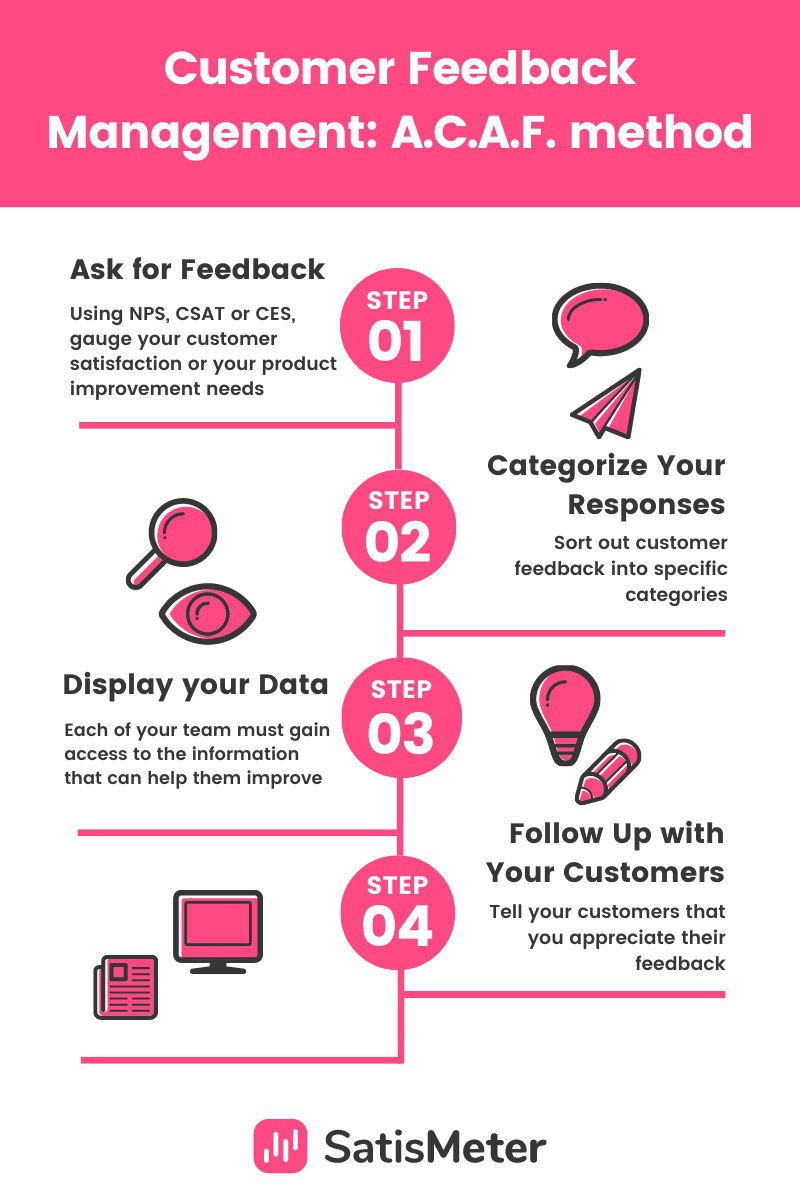
Ask, Categorize, Act and Follow-up: The ACAF process for customer feedback management
Step 1: Ask for Feedback
Asking for feedback may seem like the simplest part of the A.C.A.F. process. After all, you just want your customers to answer a few simple questions!
But for your questions – and their answers – to provide any actual value, it’s essential to tailor your questions toward tangible goals. We’ll address the three primary goals in this section.
Customer Satisfaction
One of your main goals is likely to be that you want to gain insight into customer satisfaction trends over time. That process starts by asking how satisfied they are today, so you have a benchmark to compare to in the future.
Aside from monitoring your social media accounts, there are two primary methods of gaining customer satisfaction insights.
- The first is to measure your Net Promoter Score (NPS). The NPS is a measure of how likely a person is to recommend your product or service, and it starts with a simple question:
“On a scale of 1 to 10, how likely are you to recommend [Business] or [Product] to a friend or colleague?”
Then, you calculate your NPS by subtracting the percentage of your detractors – those who rate you less than 6 – from the percentage of your promoters – customers who rate you 9 or 10.
Your NPS is also a great way to measure customer loyalty. On the whole, your promoters often have a higher customer lifetime value (LTV) than detractors.
But it can be difficult – and time-consuming – to calculate NPS on your own, and that is precisely where a service such as SatisMeter comes in handy!
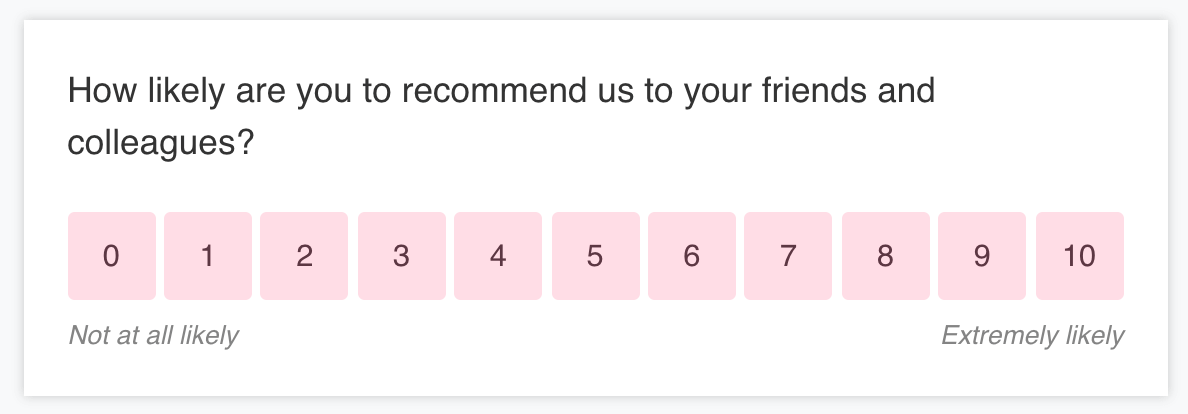
- The second method of measuring customer satisfaction is with your Customer Satisfaction Score. Your CSAT is a metric that examines how satisfied a customer is with a single interaction with your company.
And, while you can vary the question for your business, it usually looks something like this: “How happy are you with your service today?”
Typically, it’s best to take a CSAT Survey at the end of a Live Chat, knowledge-based blog content, or other interaction with a customer service representative. The goal is to learn how well a particular interaction assisted your customers.

Customer Service Concerns
You may also want to gather customer feedback related to service issues and pain points. These questions focus on your team’s performance, rather than your product.
To get at the heart of the issue, you may want to ask a combination of open-ended questions and closed-ended questions, such as:
- How happy are you with your service on a scale of 1-10?
- How was our service today?
- What was your experience like with [Customer Service Rep]?
- Is there anything we can do to improve your experience with [Business]?
Once again, you may want to turn to a Net Promoter Score Survey to get an idea of how your customers’ experiences. As a rule, a high score indicates a well-oiled customer service team. On the other hand, a low score may suggest trouble brewing on the horizon.
A CSAT can also come in handy here. You can start by asking how happy your customer is following an interaction with a customer service team member. If need be, you can follow up with specific questions on:
- How long it took to resolve the issue
- Specific questions about the conversation
- The helpfulness of a particular customer service representative
Customer Effort Scores, gathered via a CES Survey, provide even more data. You can start with a simple question: “Overall, how would you rate your ease in solving your problem today?”
A CES’s goal is to determine how much effort your customers went through to solve their problems. By measuring the difficulty of the customer problem resolution process, you can gain new insights on CSAT feedback.
The key will be to send your customer service survey immediately after a support ticket, a live chat, or a phone call has concluded. It will improve your response time – and reduce customer feedback bias.

Improving Your Products
Improving your products should be a consistent goal in your company, and customer feedback can help you get there. And like with the other goals, there are a variety of ways to gather your data.
Once again, your NPS comes in quite handy here. While it doesn’t account for product-specific issues, “How likely are you to recommend [Product] to your friends or colleagues?” is an excellent question to ask.
For more detailed information, digital marketers and SaaS products can use their apps to collect customer feedback. By utilizing this quick, built-in channel, you can ask in-depth questions such as:
- How does [Product] provide value to your business?
- Does [Product] succeed in providing its intended value?
- What issues, if any, do you have with [Product] or [Product Feature]?
- What features do you think are missing from [Product]?
Another method of gathering product-related data is to launch a feature request board. This provides customers with a way to participate in your product roadmap and have their opinions heard. Not to mention, you can foster a deeper sense of community and loyalty in the process.
But feature request boards come with their own challenges. For instance, your products will likely bias your heaviest users. Plus, many users may not contribute feedback, which leads to low response volume for your effort.
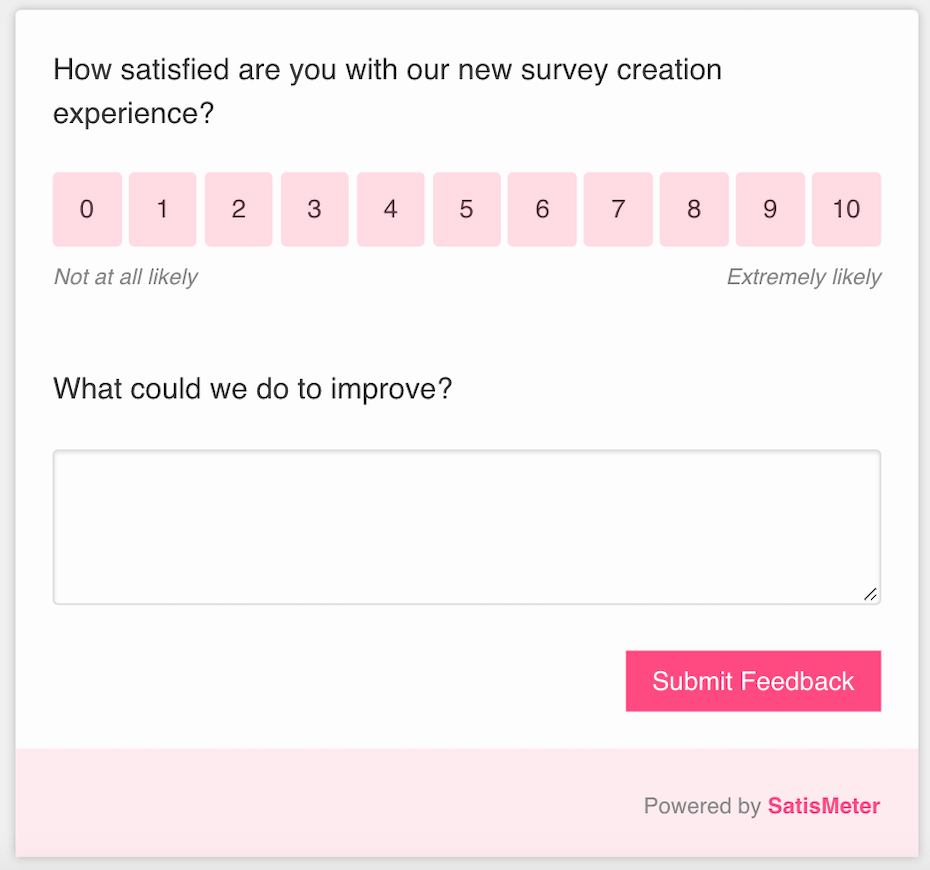
Step 2: Categorize Your Responses
Now that you have your customer feedback in hand, it’s essential to categorize it in a useful way. Otherwise, you’ll just have tons of data spread across your Excel sheets.
Customer feedback is information. Start by dividing your customer feedback into three essential categories.
Product feedback is all the information that relates to your products and services. You may further segment this data into major and minor product bugs, feature requests, and satisfaction points.
Customer service feedback is all the data you gather about customer relations with your representatives. You can use this information to identify patterns such as:
- Commonly asked questions
- Areas of clarification
- Average response times in particular mediums
- Customer pain points
Marketing and sales feedback is all the feedback that relates to the marketing and sales process. By having a tight feedback loop for your marketing and sales teams, you can avoid problems such as undelivered promises and unmet deadlines. Your goal here should be to build efficiency – and avoid unhappy customers.
Step 3: Act on Your Newfound Knowledge
Once you categorize all your customer feedback, it’s time to act on your newfound knowledge. It’s crucial to compile your data in a way that’s useful for your various teams. Then, you want to provide your information to:
- Your product/research and development teams
- Your customer support team
- The marketing and sales teams
- Relevant management teams
Whether you share your data weekly, monthly, or quarterly, each team must gain access to the information that can help them improve.
Step 4: Follow Up with Your Customers
Receiving and acting on customer feedback goes a long way to improve your business. But if you want to stay on top of your customer relations, it’s essential to follow up with your customers.
It turns out that 43% of customers don’t leave feedback because they think businesses don’t care what they have to say.
And if you think about it, this makes sense. Some companies don’t even send out a “Thank You!” acknowledging the effort customers expend to provide valuable market research.
Thus, by telling your customers that you appreciate their feedback – both positive and negative – you increase the chances that they will communicate not only their pleasures but their displeasures as well. To do so, keep in mind that you should:
- Promptly alert customers that you’ve received and are considering their feedback.
- Publish regular updates on how you’ve implemented customer feedback.
- Personalizing emails to address customers who have shared their thoughts and concerns.
In doing so, you’ll not only build fantastic relationships. You’ll also complete the A.C.A.F. Customer Feedback Loop – and satisfy yet another customer.
Sign up now
